Comprehensive Report: Prospectus Liability and Investor Protection
VerifiedAdded on 2021/06/15
|9
|2597
|28
Report
AI Summary
This report delves into the critical issue of prospectus liability, focusing on the case of Austin Retail Ltd and the potential misrepresentation of information in its prospectus. It examines the responsibilities of various parties, including the company's sales manager, DB consultants, and Dendy Securities Ltd, under the Corporations Act 2001 (Cth). The report analyzes the legal requirements for prospectuses, emphasizing the need for accurate and comprehensive information to enable informed investment decisions. It details the civil and criminal liabilities associated with untrue statements, including the potential for directors, promoters, and the corporation itself to be held accountable. Furthermore, it explores defenses available to those responsible for the prospectus and discusses the measures of damages that may be awarded to investors who have suffered losses due to misleading information, highlighting the complexities of assessing actual security values and the relevance of proportionate liability. The report also covers the due diligence defense and provides a comprehensive overview of the legal framework surrounding prospectus liability and investor protection.
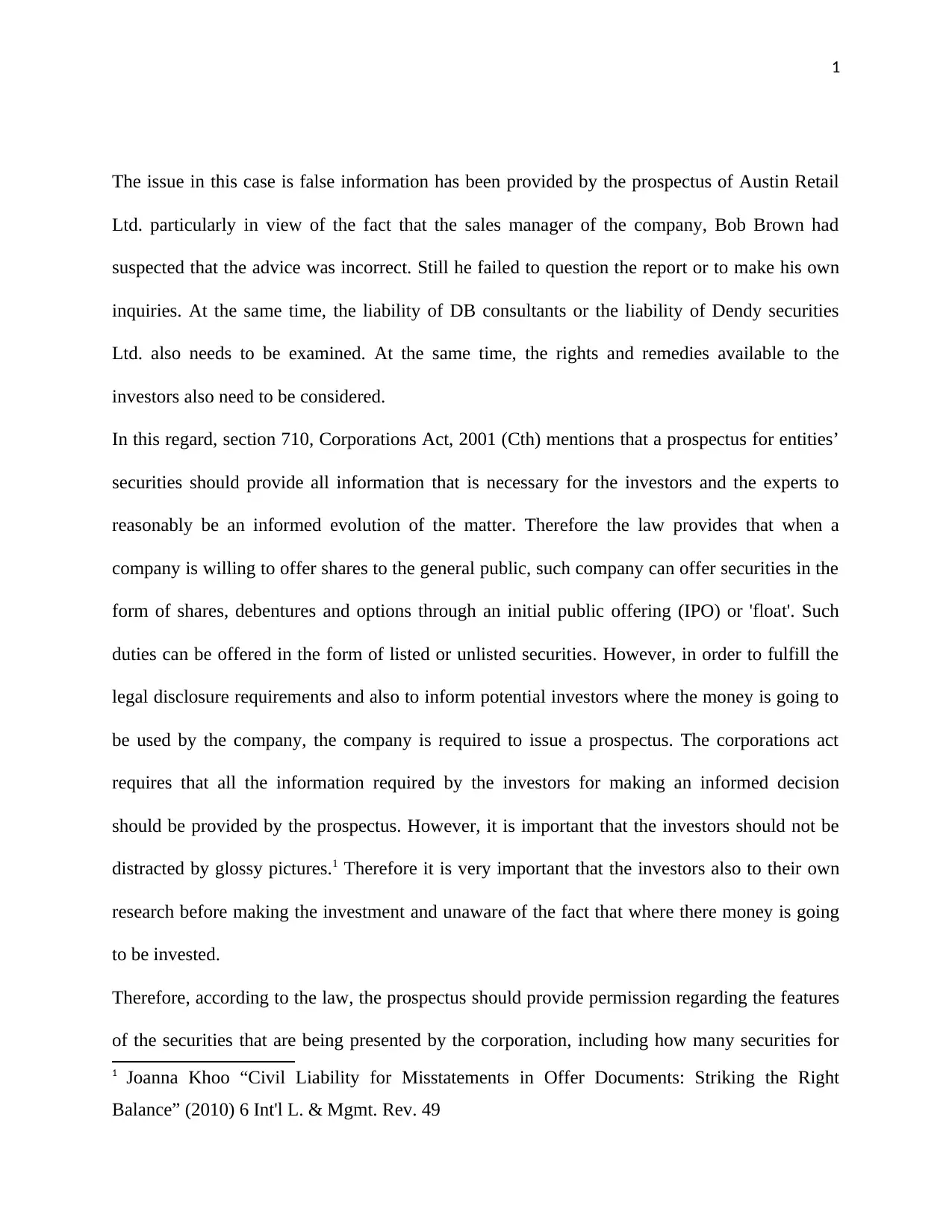
1
The issue in this case is false information has been provided by the prospectus of Austin Retail
Ltd. particularly in view of the fact that the sales manager of the company, Bob Brown had
suspected that the advice was incorrect. Still he failed to question the report or to make his own
inquiries. At the same time, the liability of DB consultants or the liability of Dendy securities
Ltd. also needs to be examined. At the same time, the rights and remedies available to the
investors also need to be considered.
In this regard, section 710, Corporations Act, 2001 (Cth) mentions that a prospectus for entities’
securities should provide all information that is necessary for the investors and the experts to
reasonably be an informed evolution of the matter. Therefore the law provides that when a
company is willing to offer shares to the general public, such company can offer securities in the
form of shares, debentures and options through an initial public offering (IPO) or 'float'. Such
duties can be offered in the form of listed or unlisted securities. However, in order to fulfill the
legal disclosure requirements and also to inform potential investors where the money is going to
be used by the company, the company is required to issue a prospectus. The corporations act
requires that all the information required by the investors for making an informed decision
should be provided by the prospectus. However, it is important that the investors should not be
distracted by glossy pictures.1 Therefore it is very important that the investors also to their own
research before making the investment and unaware of the fact that where there money is going
to be invested.
Therefore, according to the law, the prospectus should provide permission regarding the features
of the securities that are being presented by the corporation, including how many securities for
1 Joanna Khoo “Civil Liability for Misstatements in Offer Documents: Striking the Right
Balance” (2010) 6 Int'l L. & Mgmt. Rev. 49
The issue in this case is false information has been provided by the prospectus of Austin Retail
Ltd. particularly in view of the fact that the sales manager of the company, Bob Brown had
suspected that the advice was incorrect. Still he failed to question the report or to make his own
inquiries. At the same time, the liability of DB consultants or the liability of Dendy securities
Ltd. also needs to be examined. At the same time, the rights and remedies available to the
investors also need to be considered.
In this regard, section 710, Corporations Act, 2001 (Cth) mentions that a prospectus for entities’
securities should provide all information that is necessary for the investors and the experts to
reasonably be an informed evolution of the matter. Therefore the law provides that when a
company is willing to offer shares to the general public, such company can offer securities in the
form of shares, debentures and options through an initial public offering (IPO) or 'float'. Such
duties can be offered in the form of listed or unlisted securities. However, in order to fulfill the
legal disclosure requirements and also to inform potential investors where the money is going to
be used by the company, the company is required to issue a prospectus. The corporations act
requires that all the information required by the investors for making an informed decision
should be provided by the prospectus. However, it is important that the investors should not be
distracted by glossy pictures.1 Therefore it is very important that the investors also to their own
research before making the investment and unaware of the fact that where there money is going
to be invested.
Therefore, according to the law, the prospectus should provide permission regarding the features
of the securities that are being presented by the corporation, including how many securities for
1 Joanna Khoo “Civil Liability for Misstatements in Offer Documents: Striking the Right
Balance” (2010) 6 Int'l L. & Mgmt. Rev. 49
Paraphrase This Document
Need a fresh take? Get an instant paraphrase of this document with our AI Paraphraser
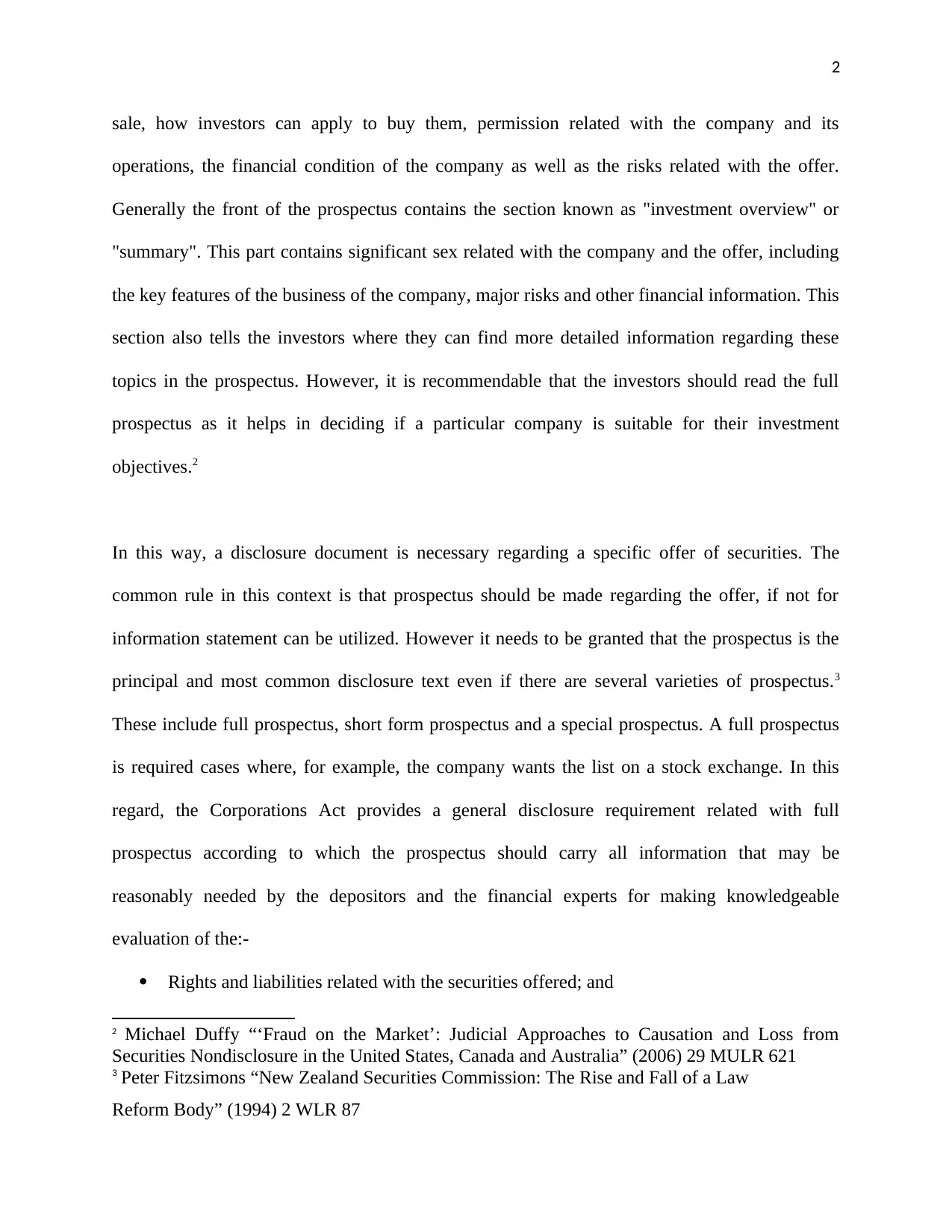
2
sale, how investors can apply to buy them, permission related with the company and its
operations, the financial condition of the company as well as the risks related with the offer.
Generally the front of the prospectus contains the section known as "investment overview" or
"summary". This part contains significant sex related with the company and the offer, including
the key features of the business of the company, major risks and other financial information. This
section also tells the investors where they can find more detailed information regarding these
topics in the prospectus. However, it is recommendable that the investors should read the full
prospectus as it helps in deciding if a particular company is suitable for their investment
objectives.2
In this way, a disclosure document is necessary regarding a specific offer of securities. The
common rule in this context is that prospectus should be made regarding the offer, if not for
information statement can be utilized. However it needs to be granted that the prospectus is the
principal and most common disclosure text even if there are several varieties of prospectus.3
These include full prospectus, short form prospectus and a special prospectus. A full prospectus
is required cases where, for example, the company wants the list on a stock exchange. In this
regard, the Corporations Act provides a general disclosure requirement related with full
prospectus according to which the prospectus should carry all information that may be
reasonably needed by the depositors and the financial experts for making knowledgeable
evaluation of the:-
Rights and liabilities related with the securities offered; and
2 Michael Duffy “‘Fraud on the Market’: Judicial Approaches to Causation and Loss from
Securities Nondisclosure in the United States, Canada and Australia” (2006) 29 MULR 621
3 Peter Fitzsimons “New Zealand Securities Commission: The Rise and Fall of a Law
Reform Body” (1994) 2 WLR 87
sale, how investors can apply to buy them, permission related with the company and its
operations, the financial condition of the company as well as the risks related with the offer.
Generally the front of the prospectus contains the section known as "investment overview" or
"summary". This part contains significant sex related with the company and the offer, including
the key features of the business of the company, major risks and other financial information. This
section also tells the investors where they can find more detailed information regarding these
topics in the prospectus. However, it is recommendable that the investors should read the full
prospectus as it helps in deciding if a particular company is suitable for their investment
objectives.2
In this way, a disclosure document is necessary regarding a specific offer of securities. The
common rule in this context is that prospectus should be made regarding the offer, if not for
information statement can be utilized. However it needs to be granted that the prospectus is the
principal and most common disclosure text even if there are several varieties of prospectus.3
These include full prospectus, short form prospectus and a special prospectus. A full prospectus
is required cases where, for example, the company wants the list on a stock exchange. In this
regard, the Corporations Act provides a general disclosure requirement related with full
prospectus according to which the prospectus should carry all information that may be
reasonably needed by the depositors and the financial experts for making knowledgeable
evaluation of the:-
Rights and liabilities related with the securities offered; and
2 Michael Duffy “‘Fraud on the Market’: Judicial Approaches to Causation and Loss from
Securities Nondisclosure in the United States, Canada and Australia” (2006) 29 MULR 621
3 Peter Fitzsimons “New Zealand Securities Commission: The Rise and Fall of a Law
Reform Body” (1994) 2 WLR 87
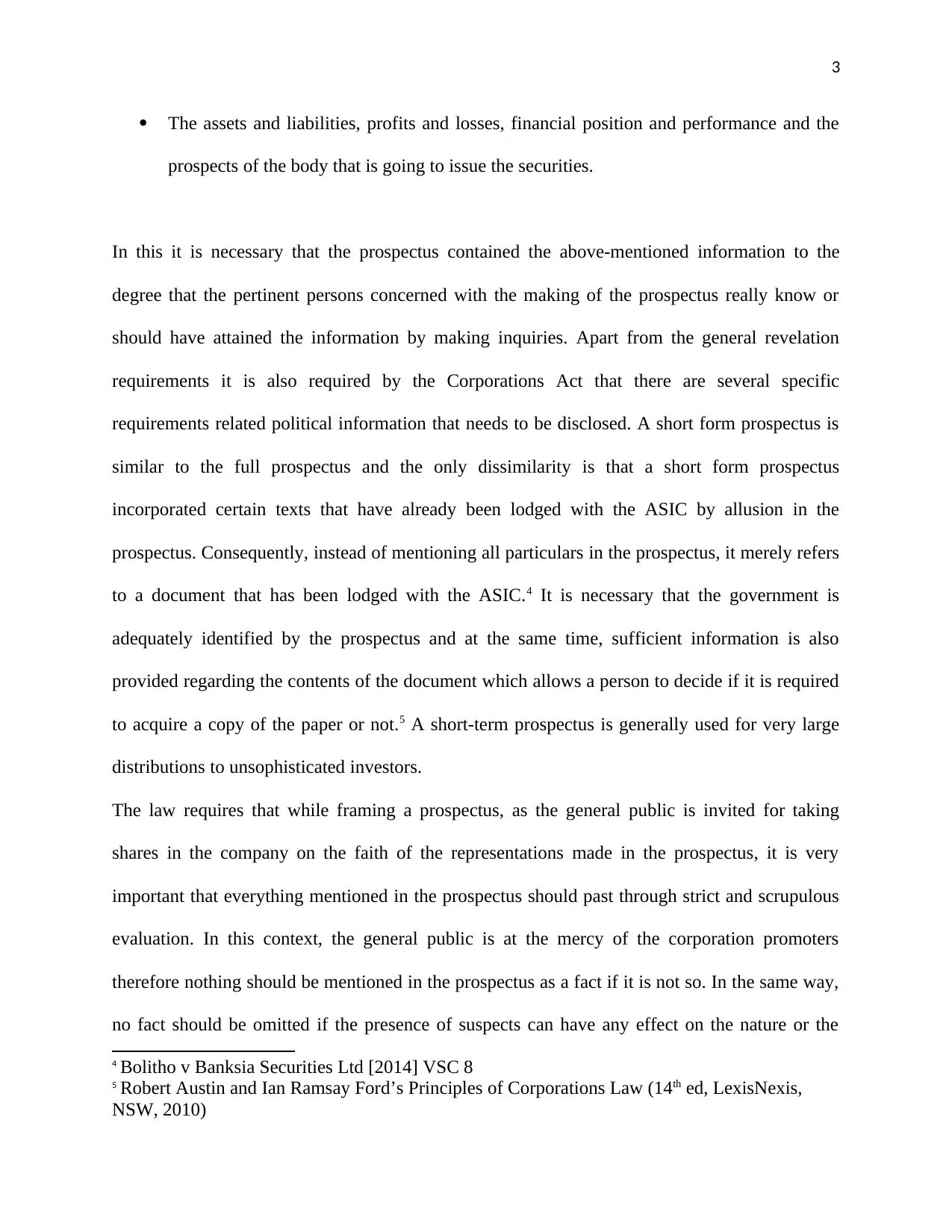
3
The assets and liabilities, profits and losses, financial position and performance and the
prospects of the body that is going to issue the securities.
In this it is necessary that the prospectus contained the above-mentioned information to the
degree that the pertinent persons concerned with the making of the prospectus really know or
should have attained the information by making inquiries. Apart from the general revelation
requirements it is also required by the Corporations Act that there are several specific
requirements related political information that needs to be disclosed. A short form prospectus is
similar to the full prospectus and the only dissimilarity is that a short form prospectus
incorporated certain texts that have already been lodged with the ASIC by allusion in the
prospectus. Consequently, instead of mentioning all particulars in the prospectus, it merely refers
to a document that has been lodged with the ASIC.4 It is necessary that the government is
adequately identified by the prospectus and at the same time, sufficient information is also
provided regarding the contents of the document which allows a person to decide if it is required
to acquire a copy of the paper or not.5 A short-term prospectus is generally used for very large
distributions to unsophisticated investors.
The law requires that while framing a prospectus, as the general public is invited for taking
shares in the company on the faith of the representations made in the prospectus, it is very
important that everything mentioned in the prospectus should past through strict and scrupulous
evaluation. In this context, the general public is at the mercy of the corporation promoters
therefore nothing should be mentioned in the prospectus as a fact if it is not so. In the same way,
no fact should be omitted if the presence of suspects can have any effect on the nature or the
4 Bolitho v Banksia Securities Ltd [2014] VSC 8
5 Robert Austin and Ian Ramsay Ford’s Principles of Corporations Law (14th ed, LexisNexis,
NSW, 2010)
The assets and liabilities, profits and losses, financial position and performance and the
prospects of the body that is going to issue the securities.
In this it is necessary that the prospectus contained the above-mentioned information to the
degree that the pertinent persons concerned with the making of the prospectus really know or
should have attained the information by making inquiries. Apart from the general revelation
requirements it is also required by the Corporations Act that there are several specific
requirements related political information that needs to be disclosed. A short form prospectus is
similar to the full prospectus and the only dissimilarity is that a short form prospectus
incorporated certain texts that have already been lodged with the ASIC by allusion in the
prospectus. Consequently, instead of mentioning all particulars in the prospectus, it merely refers
to a document that has been lodged with the ASIC.4 It is necessary that the government is
adequately identified by the prospectus and at the same time, sufficient information is also
provided regarding the contents of the document which allows a person to decide if it is required
to acquire a copy of the paper or not.5 A short-term prospectus is generally used for very large
distributions to unsophisticated investors.
The law requires that while framing a prospectus, as the general public is invited for taking
shares in the company on the faith of the representations made in the prospectus, it is very
important that everything mentioned in the prospectus should past through strict and scrupulous
evaluation. In this context, the general public is at the mercy of the corporation promoters
therefore nothing should be mentioned in the prospectus as a fact if it is not so. In the same way,
no fact should be omitted if the presence of suspects can have any effect on the nature or the
4 Bolitho v Banksia Securities Ltd [2014] VSC 8
5 Robert Austin and Ian Ramsay Ford’s Principles of Corporations Law (14th ed, LexisNexis,
NSW, 2010)
⊘ This is a preview!⊘
Do you want full access?
Subscribe today to unlock all pages.

Trusted by 1+ million students worldwide

4
quality of privileges and advantages that make it as an inducement for the investors. Therefore,
the prospectus should reveal the true nature of the company's venture.6
On the other hand, a statement mentioned in the prospectus will be considered as untrue if such
statement is misleading and form and in the context in which it was added in the prospectus. In
cases where there is an omission of a matter from the prospectus and this has been done with a
view to mislead the general public, it can be considered that the prospectus includes an untrue
statement. Not only in case of the prospectus, a statement can also be considered as misleading
even if it is present in any report or memory under that has been incorporated in the prospectus
or issued therewith. The liability arises where any person has subscribed for shares or debentures
by relying on the prospectus regarding any loss that may be suffered by such person due to the
incorrect declaration present in the prospectus.7
In case of a misstatement made in the prospectus, the law provides that certain persons can be
held liable for paying compensation to the persons who had subscribed for the shares or
debentures by relying on the prospectus, for any loss that may be suffered by these persons due
to the presence of an incorrect declaration in the prospectus. These persons include the directors
of the corporation, promoters or even the corporation itself. It is worth mentioning that in this
regard, it is immaterial if the director has seen the prospectus or not, it is sufficient that the
director has authorized the issuance of the prospectus. The purpose behind imposing civil
liability for misstatement in the prospectus is to protect the rights of the shareholders who have
been deceived by acting on the wrong statement mentioned in the prospectus. As a result, the
duties of the directors and other persons were elated with the issue of prospectus increase
6 Campbell v Back Office Investments Pty Ltd [2008] NSWCA 95
7 Louis Loss and Joel Seligman Fundamentals of Securities Regulation (5th ed, Aspen
Publishers, New York, 2004)
quality of privileges and advantages that make it as an inducement for the investors. Therefore,
the prospectus should reveal the true nature of the company's venture.6
On the other hand, a statement mentioned in the prospectus will be considered as untrue if such
statement is misleading and form and in the context in which it was added in the prospectus. In
cases where there is an omission of a matter from the prospectus and this has been done with a
view to mislead the general public, it can be considered that the prospectus includes an untrue
statement. Not only in case of the prospectus, a statement can also be considered as misleading
even if it is present in any report or memory under that has been incorporated in the prospectus
or issued therewith. The liability arises where any person has subscribed for shares or debentures
by relying on the prospectus regarding any loss that may be suffered by such person due to the
incorrect declaration present in the prospectus.7
In case of a misstatement made in the prospectus, the law provides that certain persons can be
held liable for paying compensation to the persons who had subscribed for the shares or
debentures by relying on the prospectus, for any loss that may be suffered by these persons due
to the presence of an incorrect declaration in the prospectus. These persons include the directors
of the corporation, promoters or even the corporation itself. It is worth mentioning that in this
regard, it is immaterial if the director has seen the prospectus or not, it is sufficient that the
director has authorized the issuance of the prospectus. The purpose behind imposing civil
liability for misstatement in the prospectus is to protect the rights of the shareholders who have
been deceived by acting on the wrong statement mentioned in the prospectus. As a result, the
duties of the directors and other persons were elated with the issue of prospectus increase
6 Campbell v Back Office Investments Pty Ltd [2008] NSWCA 95
7 Louis Loss and Joel Seligman Fundamentals of Securities Regulation (5th ed, Aspen
Publishers, New York, 2004)
Paraphrase This Document
Need a fresh take? Get an instant paraphrase of this document with our AI Paraphraser
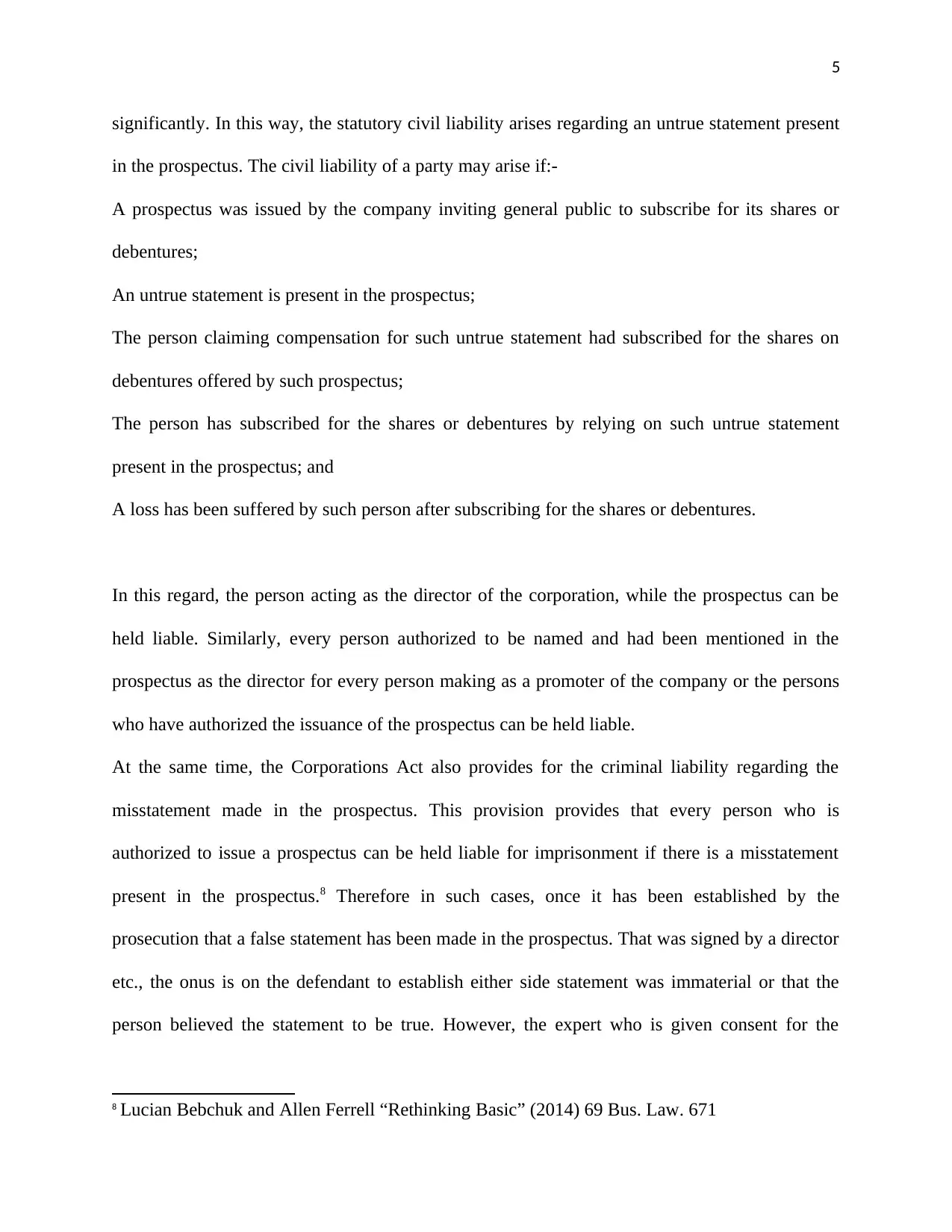
5
significantly. In this way, the statutory civil liability arises regarding an untrue statement present
in the prospectus. The civil liability of a party may arise if:-
A prospectus was issued by the company inviting general public to subscribe for its shares or
debentures;
An untrue statement is present in the prospectus;
The person claiming compensation for such untrue statement had subscribed for the shares on
debentures offered by such prospectus;
The person has subscribed for the shares or debentures by relying on such untrue statement
present in the prospectus; and
A loss has been suffered by such person after subscribing for the shares or debentures.
In this regard, the person acting as the director of the corporation, while the prospectus can be
held liable. Similarly, every person authorized to be named and had been mentioned in the
prospectus as the director for every person making as a promoter of the company or the persons
who have authorized the issuance of the prospectus can be held liable.
At the same time, the Corporations Act also provides for the criminal liability regarding the
misstatement made in the prospectus. This provision provides that every person who is
authorized to issue a prospectus can be held liable for imprisonment if there is a misstatement
present in the prospectus.8 Therefore in such cases, once it has been established by the
prosecution that a false statement has been made in the prospectus. That was signed by a director
etc., the onus is on the defendant to establish either side statement was immaterial or that the
person believed the statement to be true. However, the expert who is given consent for the
8 Lucian Bebchuk and Allen Ferrell “Rethinking Basic” (2014) 69 Bus. Law. 671
significantly. In this way, the statutory civil liability arises regarding an untrue statement present
in the prospectus. The civil liability of a party may arise if:-
A prospectus was issued by the company inviting general public to subscribe for its shares or
debentures;
An untrue statement is present in the prospectus;
The person claiming compensation for such untrue statement had subscribed for the shares on
debentures offered by such prospectus;
The person has subscribed for the shares or debentures by relying on such untrue statement
present in the prospectus; and
A loss has been suffered by such person after subscribing for the shares or debentures.
In this regard, the person acting as the director of the corporation, while the prospectus can be
held liable. Similarly, every person authorized to be named and had been mentioned in the
prospectus as the director for every person making as a promoter of the company or the persons
who have authorized the issuance of the prospectus can be held liable.
At the same time, the Corporations Act also provides for the criminal liability regarding the
misstatement made in the prospectus. This provision provides that every person who is
authorized to issue a prospectus can be held liable for imprisonment if there is a misstatement
present in the prospectus.8 Therefore in such cases, once it has been established by the
prosecution that a false statement has been made in the prospectus. That was signed by a director
etc., the onus is on the defendant to establish either side statement was immaterial or that the
person believed the statement to be true. However, the expert who is given consent for the
8 Lucian Bebchuk and Allen Ferrell “Rethinking Basic” (2014) 69 Bus. Law. 671
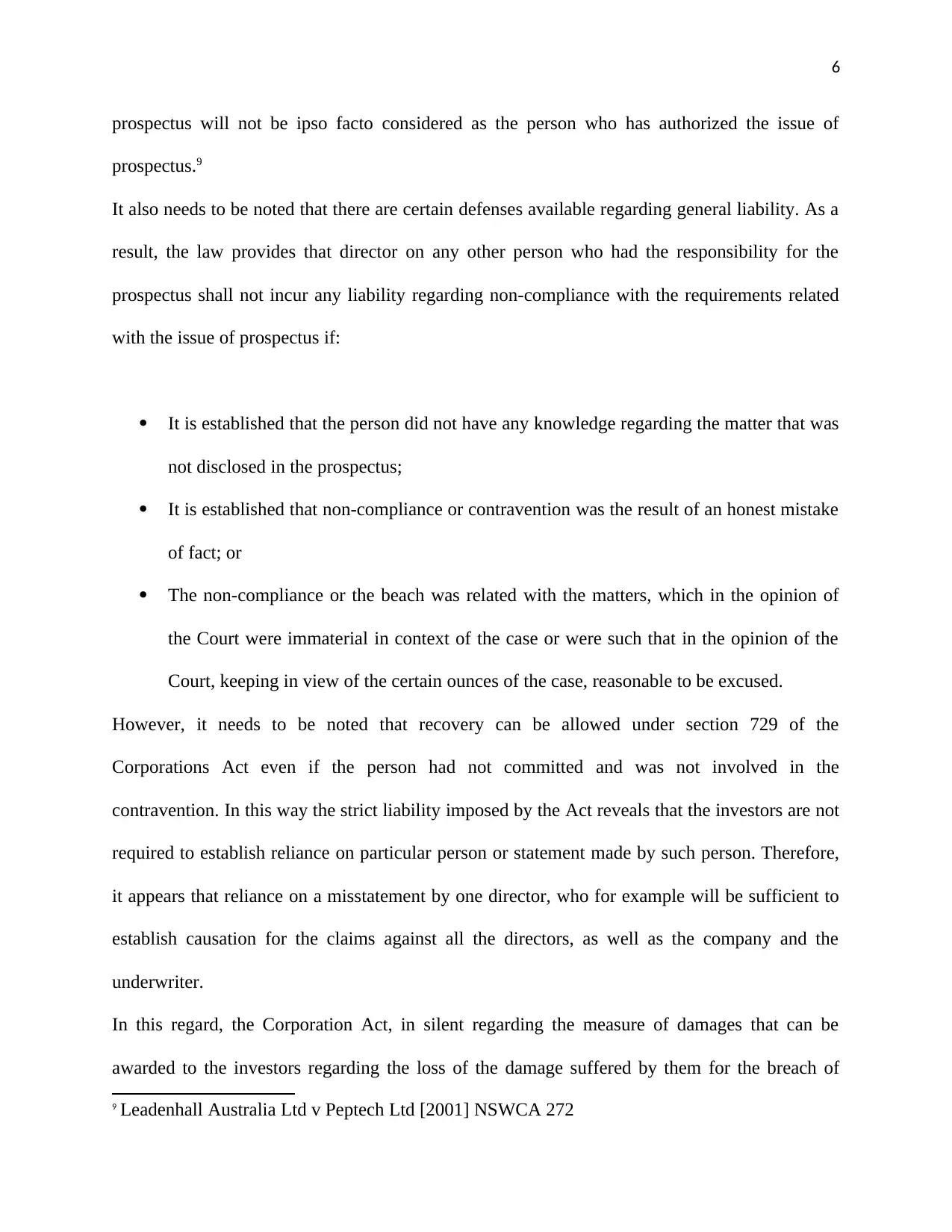
6
prospectus will not be ipso facto considered as the person who has authorized the issue of
prospectus.9
It also needs to be noted that there are certain defenses available regarding general liability. As a
result, the law provides that director on any other person who had the responsibility for the
prospectus shall not incur any liability regarding non-compliance with the requirements related
with the issue of prospectus if:
It is established that the person did not have any knowledge regarding the matter that was
not disclosed in the prospectus;
It is established that non-compliance or contravention was the result of an honest mistake
of fact; or
The non-compliance or the beach was related with the matters, which in the opinion of
the Court were immaterial in context of the case or were such that in the opinion of the
Court, keeping in view of the certain ounces of the case, reasonable to be excused.
However, it needs to be noted that recovery can be allowed under section 729 of the
Corporations Act even if the person had not committed and was not involved in the
contravention. In this way the strict liability imposed by the Act reveals that the investors are not
required to establish reliance on particular person or statement made by such person. Therefore,
it appears that reliance on a misstatement by one director, who for example will be sufficient to
establish causation for the claims against all the directors, as well as the company and the
underwriter.
In this regard, the Corporation Act, in silent regarding the measure of damages that can be
awarded to the investors regarding the loss of the damage suffered by them for the breach of
9 Leadenhall Australia Ltd v Peptech Ltd [2001] NSWCA 272
prospectus will not be ipso facto considered as the person who has authorized the issue of
prospectus.9
It also needs to be noted that there are certain defenses available regarding general liability. As a
result, the law provides that director on any other person who had the responsibility for the
prospectus shall not incur any liability regarding non-compliance with the requirements related
with the issue of prospectus if:
It is established that the person did not have any knowledge regarding the matter that was
not disclosed in the prospectus;
It is established that non-compliance or contravention was the result of an honest mistake
of fact; or
The non-compliance or the beach was related with the matters, which in the opinion of
the Court were immaterial in context of the case or were such that in the opinion of the
Court, keeping in view of the certain ounces of the case, reasonable to be excused.
However, it needs to be noted that recovery can be allowed under section 729 of the
Corporations Act even if the person had not committed and was not involved in the
contravention. In this way the strict liability imposed by the Act reveals that the investors are not
required to establish reliance on particular person or statement made by such person. Therefore,
it appears that reliance on a misstatement by one director, who for example will be sufficient to
establish causation for the claims against all the directors, as well as the company and the
underwriter.
In this regard, the Corporation Act, in silent regarding the measure of damages that can be
awarded to the investors regarding the loss of the damage suffered by them for the breach of
9 Leadenhall Australia Ltd v Peptech Ltd [2001] NSWCA 272
⊘ This is a preview!⊘
Do you want full access?
Subscribe today to unlock all pages.

Trusted by 1+ million students worldwide
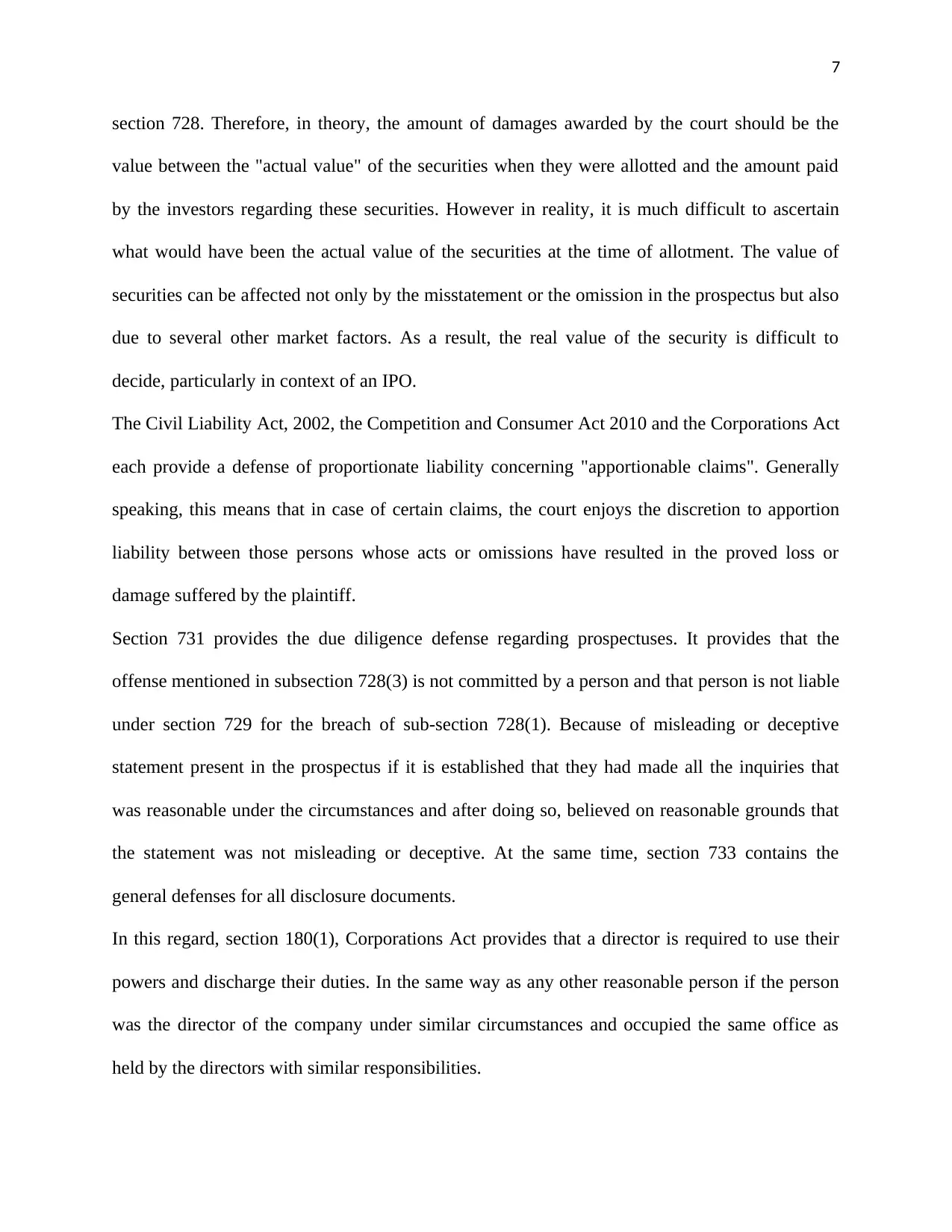
7
section 728. Therefore, in theory, the amount of damages awarded by the court should be the
value between the "actual value" of the securities when they were allotted and the amount paid
by the investors regarding these securities. However in reality, it is much difficult to ascertain
what would have been the actual value of the securities at the time of allotment. The value of
securities can be affected not only by the misstatement or the omission in the prospectus but also
due to several other market factors. As a result, the real value of the security is difficult to
decide, particularly in context of an IPO.
The Civil Liability Act, 2002, the Competition and Consumer Act 2010 and the Corporations Act
each provide a defense of proportionate liability concerning "apportionable claims". Generally
speaking, this means that in case of certain claims, the court enjoys the discretion to apportion
liability between those persons whose acts or omissions have resulted in the proved loss or
damage suffered by the plaintiff.
Section 731 provides the due diligence defense regarding prospectuses. It provides that the
offense mentioned in subsection 728(3) is not committed by a person and that person is not liable
under section 729 for the breach of sub-section 728(1). Because of misleading or deceptive
statement present in the prospectus if it is established that they had made all the inquiries that
was reasonable under the circumstances and after doing so, believed on reasonable grounds that
the statement was not misleading or deceptive. At the same time, section 733 contains the
general defenses for all disclosure documents.
In this regard, section 180(1), Corporations Act provides that a director is required to use their
powers and discharge their duties. In the same way as any other reasonable person if the person
was the director of the company under similar circumstances and occupied the same office as
held by the directors with similar responsibilities.
section 728. Therefore, in theory, the amount of damages awarded by the court should be the
value between the "actual value" of the securities when they were allotted and the amount paid
by the investors regarding these securities. However in reality, it is much difficult to ascertain
what would have been the actual value of the securities at the time of allotment. The value of
securities can be affected not only by the misstatement or the omission in the prospectus but also
due to several other market factors. As a result, the real value of the security is difficult to
decide, particularly in context of an IPO.
The Civil Liability Act, 2002, the Competition and Consumer Act 2010 and the Corporations Act
each provide a defense of proportionate liability concerning "apportionable claims". Generally
speaking, this means that in case of certain claims, the court enjoys the discretion to apportion
liability between those persons whose acts or omissions have resulted in the proved loss or
damage suffered by the plaintiff.
Section 731 provides the due diligence defense regarding prospectuses. It provides that the
offense mentioned in subsection 728(3) is not committed by a person and that person is not liable
under section 729 for the breach of sub-section 728(1). Because of misleading or deceptive
statement present in the prospectus if it is established that they had made all the inquiries that
was reasonable under the circumstances and after doing so, believed on reasonable grounds that
the statement was not misleading or deceptive. At the same time, section 733 contains the
general defenses for all disclosure documents.
In this regard, section 180(1), Corporations Act provides that a director is required to use their
powers and discharge their duties. In the same way as any other reasonable person if the person
was the director of the company under similar circumstances and occupied the same office as
held by the directors with similar responsibilities.
Paraphrase This Document
Need a fresh take? Get an instant paraphrase of this document with our AI Paraphraser

8
Under section 1317E, the remedies for the breach of a civil penalty provision can be described as
follows. If the court is satisfied that a suburban and the provision has been breached by a person,
it should make a declaration of contravention of the section 1317E(1). A person who has
contravened civil penalty provision can be ordered by the court to be a pecuniary penalty of up to
$200,000. Under section 1317G.
Therefore in the present case, the Corporation Austin Retail Ltd. as well as the directors of the
company and Dendy Securities that was named as the underwriter in the prospectus can be held
liable towards the investors for the loss suffered by the investors on account of the misstatement
made in the prospectus of the company.
Under section 1317E, the remedies for the breach of a civil penalty provision can be described as
follows. If the court is satisfied that a suburban and the provision has been breached by a person,
it should make a declaration of contravention of the section 1317E(1). A person who has
contravened civil penalty provision can be ordered by the court to be a pecuniary penalty of up to
$200,000. Under section 1317G.
Therefore in the present case, the Corporation Austin Retail Ltd. as well as the directors of the
company and Dendy Securities that was named as the underwriter in the prospectus can be held
liable towards the investors for the loss suffered by the investors on account of the misstatement
made in the prospectus of the company.
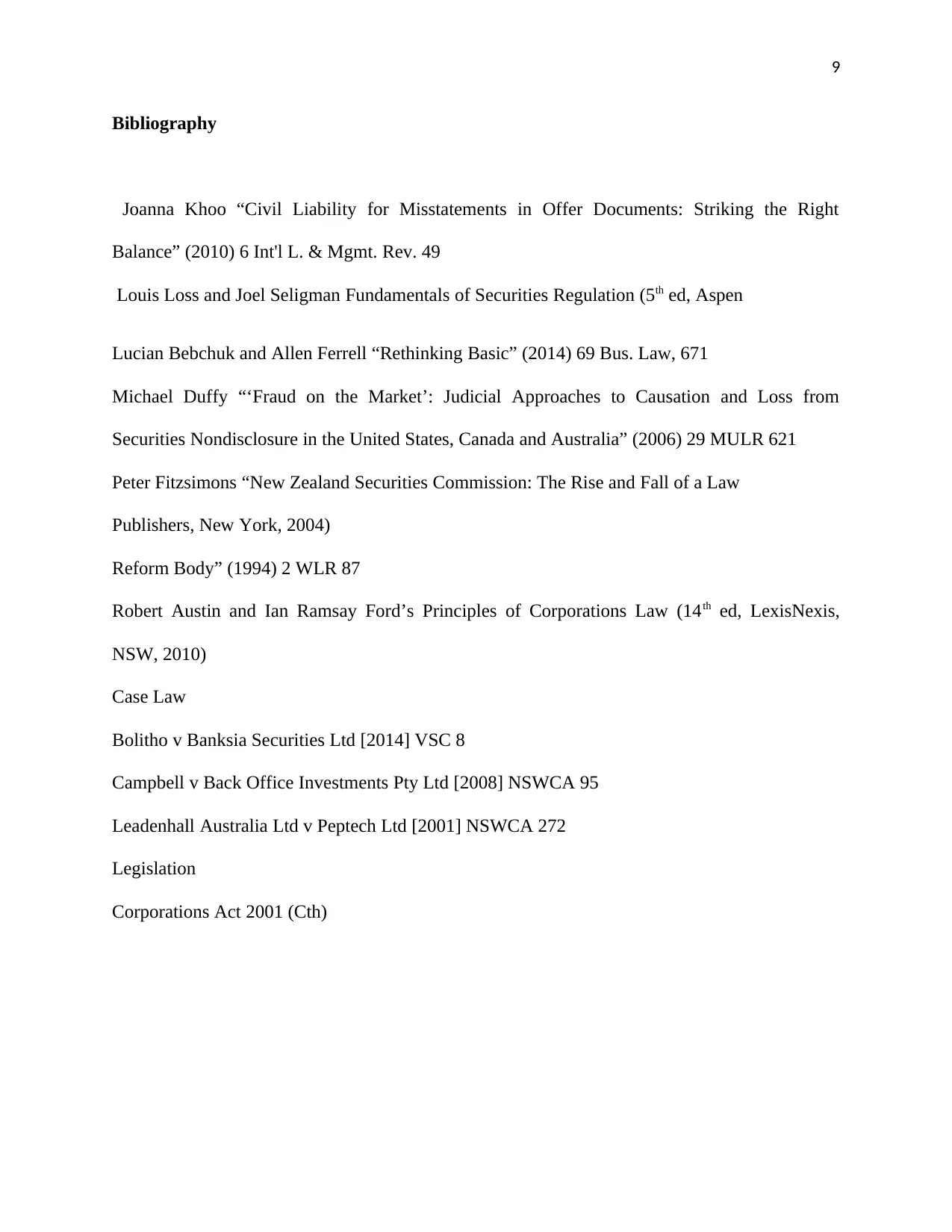
9
Bibliography
Joanna Khoo “Civil Liability for Misstatements in Offer Documents: Striking the Right
Balance” (2010) 6 Int'l L. & Mgmt. Rev. 49
Louis Loss and Joel Seligman Fundamentals of Securities Regulation (5th ed, Aspen
Lucian Bebchuk and Allen Ferrell “Rethinking Basic” (2014) 69 Bus. Law, 671
Michael Duffy “‘Fraud on the Market’: Judicial Approaches to Causation and Loss from
Securities Nondisclosure in the United States, Canada and Australia” (2006) 29 MULR 621
Peter Fitzsimons “New Zealand Securities Commission: The Rise and Fall of a Law
Publishers, New York, 2004)
Reform Body” (1994) 2 WLR 87
Robert Austin and Ian Ramsay Ford’s Principles of Corporations Law (14th ed, LexisNexis,
NSW, 2010)
Case Law
Bolitho v Banksia Securities Ltd [2014] VSC 8
Campbell v Back Office Investments Pty Ltd [2008] NSWCA 95
Leadenhall Australia Ltd v Peptech Ltd [2001] NSWCA 272
Legislation
Corporations Act 2001 (Cth)
Bibliography
Joanna Khoo “Civil Liability for Misstatements in Offer Documents: Striking the Right
Balance” (2010) 6 Int'l L. & Mgmt. Rev. 49
Louis Loss and Joel Seligman Fundamentals of Securities Regulation (5th ed, Aspen
Lucian Bebchuk and Allen Ferrell “Rethinking Basic” (2014) 69 Bus. Law, 671
Michael Duffy “‘Fraud on the Market’: Judicial Approaches to Causation and Loss from
Securities Nondisclosure in the United States, Canada and Australia” (2006) 29 MULR 621
Peter Fitzsimons “New Zealand Securities Commission: The Rise and Fall of a Law
Publishers, New York, 2004)
Reform Body” (1994) 2 WLR 87
Robert Austin and Ian Ramsay Ford’s Principles of Corporations Law (14th ed, LexisNexis,
NSW, 2010)
Case Law
Bolitho v Banksia Securities Ltd [2014] VSC 8
Campbell v Back Office Investments Pty Ltd [2008] NSWCA 95
Leadenhall Australia Ltd v Peptech Ltd [2001] NSWCA 272
Legislation
Corporations Act 2001 (Cth)
⊘ This is a preview!⊘
Do you want full access?
Subscribe today to unlock all pages.

Trusted by 1+ million students worldwide
1 out of 9
Related Documents
Your All-in-One AI-Powered Toolkit for Academic Success.
+13062052269
info@desklib.com
Available 24*7 on WhatsApp / Email
![[object Object]](/_next/static/media/star-bottom.7253800d.svg)
Unlock your academic potential
Copyright © 2020–2025 A2Z Services. All Rights Reserved. Developed and managed by ZUCOL.





